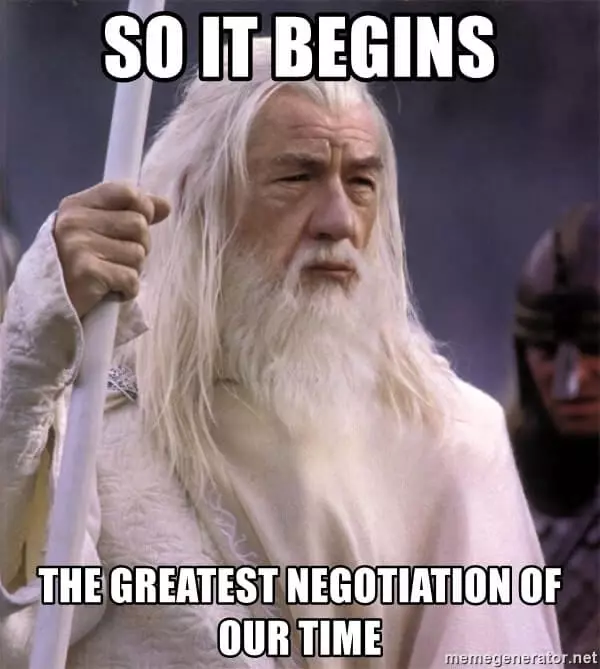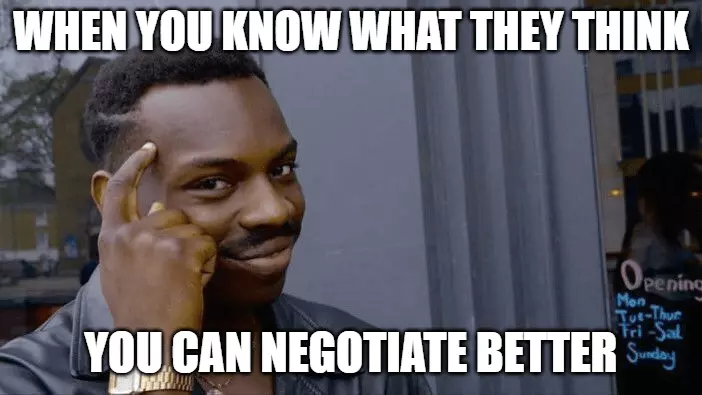Whether you’re cold calling or emailing your prospects, you will always have to negotiate.

Not every buyer or client is the same. Some won’t care whether you make a profit or not, and some might want to overpay you to ensure quality. When you’re running a business, you can’t lose out on any of them.
Thus, learning how to negotiate with prospects without becoming aggressive or desperate can keep your business afloat for years to come.
What To Do Before You Engage in Negotiation
You don’t want a situation where one minute you’re confident, and the next, you are scrambling for the right words. The solution lies in walking into a negotiation well prepared.

The most important part of negotiation preparation is conducting customer-centric research. Work to understand what your customer values most in the negotiation. Helping you adapt your presentation to focus on how best your solution can meet their expectations.
Keep In Mind What Motivates Them

You’ll have to balance your self-interest with your prospect’s interests. Rather than trying to control every point, it’s better to think of the conversation as a negotiation of interests, where you work out what’s best for each party.
That starts with knowing exactly what the other side wants and what motivates them.
Expect The Unexpected
When communicating with prospects via cold emailing, expect clients to ask tough questions- it’s understandable they want to get the most out of the deal. Avoid embarrassments by imagining and preparing for possible scenarios potential buyers may bring up along the negotiation process.
Remove Your Negative Emotions
You must deactivate your hostile emotions before you go in for the negotiation. Your fear of losing the client, anger by assuming the worst, or being suspicious of anything. Removing these negative emotions reduces activity in your amygdala.
From a neurological standpoint having less activity in your amygdala helps you focus better. So when you come across a bad situation you will be able to tactically handle the situation smoothly.
Research Competitor Offers
It’s valuable to learn about the alternatives the competition offers. Figure out the average price for your product/service and buying trends as well. Use the market information to formulate a core negotiation strategy that wins you a competitive advantage.
We complied and listed the exact tactics we use to negotiate with clients. Let us get down to business.
- Talk to the Decision-Maker
- Listen first and speak later
- Be transparent
- Ask questions
- Define concessions
- Negotiate for a longer period
- Know When To Stop
- It’s not just about money
- Don’t Get Stuck With Price Ranges
- Don’t accept a low offer
- Never give away your profit
- The relation comes first
- Learn To Walk Away
- Craft precise terms
Find and Talk To a Decision-Maker
Effective negotiation requires more than an excellent pitch. It also requires you to identify and reach out to the right person — that means a leader or anyone with a say in the decision-making process in your target company.
Listen Carefully
Seasoned sales reps don’t go about pushing what they want to sell. Instead, they listen well to assess a situation better and achieve a win-win agreement.

Avoid interrupting your potential clients- actively listen when they are speaking, and take notes. Use the information to select the best words and arguments for a successful negotiation.
Let Them Speak First
Avoid the temptation to offer a discount or an adjustment upfront. Having presented your terms of the deal, it pays to have the prospect start the conversation. That enables you to fill in the blank and modify your offer to appeal more to a prospective client.
Always Be Transparent
Negotiations are more successful when both particles are transparent about their dual needs. You both want to maximize the value of what you get from the deal.
But it helps to build an open conversation around your and their needs. Explain what your customer will gain at your price, but again assure them that your ultimate goal is to see them satisfied.
Don’t Be Afraid To Ask Questions
Rather than just rumbling about your expectations, ask sensible questions that will take you to the heart of your customers’ priorities. Perhaps they’ve been defrauded in the past, and they want to feel a little bit in control.
Or they are comparing apples to oranges using industry benchmarks. Examining the details can help position your offer as the most logical choice for the prospect.
Define Concessions
Before meeting with a decision-maker, define your limits of compromises (think discounts, add-ons, freebies, etc.). That helps set boundaries of the negotiation and ensure a mutually beneficial contract.
Remember that the other party will have concessions of their own. But don’t make the mistake of being too rigid to concede anything. You might, for instance, agree to offer a discount only under particular conditions.
Alternatively, you can stick to your price but sweeten the deal with an additional perk.
Keep Them Hooked On Negotiation Longer Period
Be open to a thoughtful, long-term negotiation process. However, keeping your potential client hooked doesn’t mean stalling the conversation. It’s about being patient, taking it slow, and profoundly reflecting on things.
That allows you to think about your following words carefully. Couple that with an attitude that reflects your commitment to finding a mutually satisfactory outcome and see the potential client equally value the negotiation process.
Know When To Stop Negotiating
It’s tempting to negotiate for every single benefit. But there’s a risk and opportunity cost to pushing too much. It makes you appear short-sighted and desperate and will certainly not get you what you want.
While you may try leveraging the “I can’t lose” mentality, knowing when to draw the line is critical for the entire sales process.
Provide Value More Than Money
Desist from negotiating on price alone. Focus on improving buyers’ perception of and satisfaction with your offer. Freebies and add-ons can help add value to your product or service; however, keep your limits in mind.
Don’t Get Stuck With Price Ranges
Avoid the word “Between” at all costs when discussing your pricing. Your best bet is to quote a specific figure, then go lower or higher accordingly. After all, a price that’s too low will only hurt your profit in the long run.
Support your figures with facts; else, your customers may feel like you are tricking them into paying higher prices to maximize your profits.
Opinions are rarely welcome in sales conversations, which is why you should strive to defend future negotiations with facts. That includes the prevailing market rates, similar deals you’ve completed, and the value offered by your product (ROI).
Don’t Accept Low Ball Offers
Your company deserves fair compensation for the resources invested in fulfilling your end of the bargain. So, if a customer suggests unreasonable terms, stay firm to defend your stance.

Let’s assume you are selling a solution at $150, and your prospect wants a 50% discount. Though it may seem a logical step, don’t counter with $100. Even if you’re haggling with a current client, offer a slight price reduction, keeping the final figure close to the original price.
Don’t Kill Your Profit
Profits are the lifeblood of any business. As such, you don’t want to reject something valuable to your business. But beyond that, you need to know exactly what your worth is.
If you let customers control sales negotiations, you risk killing your profit. The bottom line is to have a specific number in mind before talking to a potential client because you don’t want to get talked into anything. And once you get there, be as firm as possible.
Don’t be kind to accept the first deal they hear. Ensure that your business is benefiting. Else, always feel free to walk away from a bad deal.
Build Relationship First Then Sales
Focusing too much on getting sales gives off a money-grubbing vibe. When you build relations, sales will follow. Whereas negotiations help parties settle differences, they are no stranger to emotional moments.
A win-win situation requires that you focus on interests, not positions, and invent options for mutual gain. Cognizant that you anticipate a beneficial relationship after signing the deal, keep the conversation light and upbeat.
Learn When To Walk Away
If you’ve tried everything but don’t see an improvement, the negotiation process has likely stalled for good. In that case, don’t hesitate to walk away.
Stubborn buyers who only sign contracts following drastic changes to the terms or a significant cut in the price will only cause problems down the road.
For your peace of mind, get comfortable saying no. You can always start all over again!
Write Precise Terms
Avoid ambiguous terms and flowery language when drafting a business agreement. The product/service contract must spell out all the expectations.
We recommend having a contract attorney review the document before any party signs it.
Conclusion
Negotiation is an inherent part of the sales process. But it’s one thing to imagine walking into a conversation and walking out with a better deal; it’s another to put business negotiation skills into practice. So many things can go wrong in your cold email but be certain your negotiations won’t be a problem anymore.
Mastering the art of negotiating with prospects shouldn’t have to wear you down. Take advantage of the above sales negotiation tips to close more deals- without losing clients. You can also use these techniques to form a solid foundation for your in-house sales negotiation training.
Free 14-Day Trial
Start building relationships now with your fully-featured 14-day trial!
How We Compare
Terms | Done-For-You Terms | Privacy | Write For Us | Press
© 2025 Postaga. All Rights Reserved. Made with 
